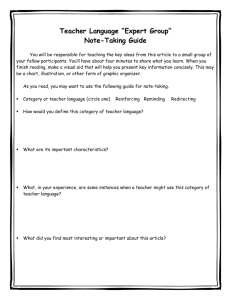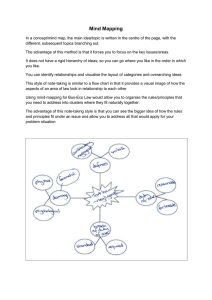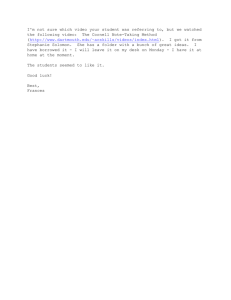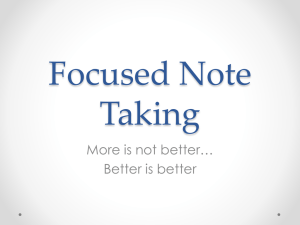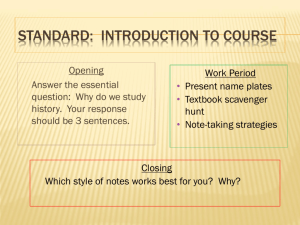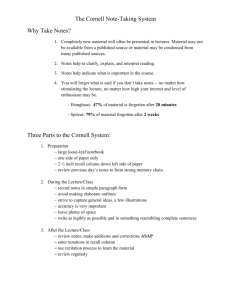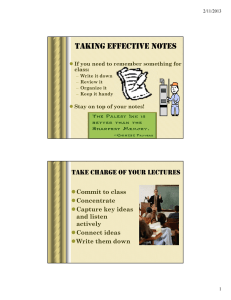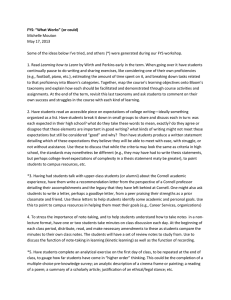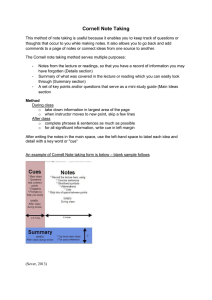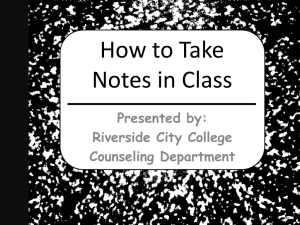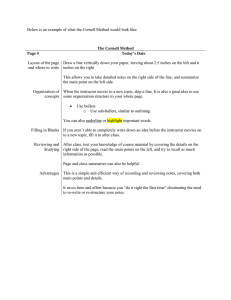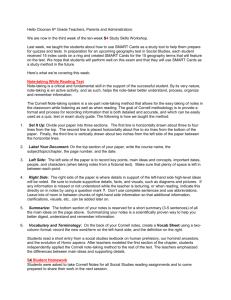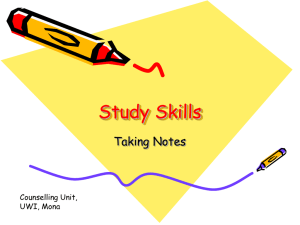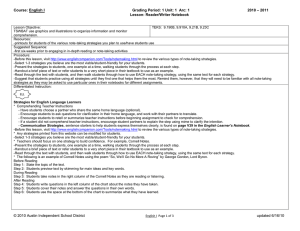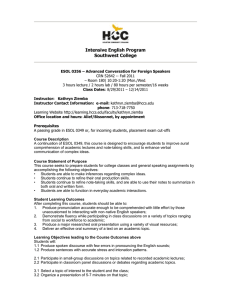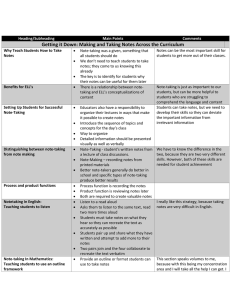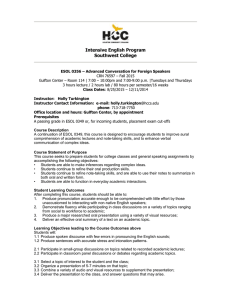STUDY-SKILLS-TOPIC-NOTE-TAKING
advertisement
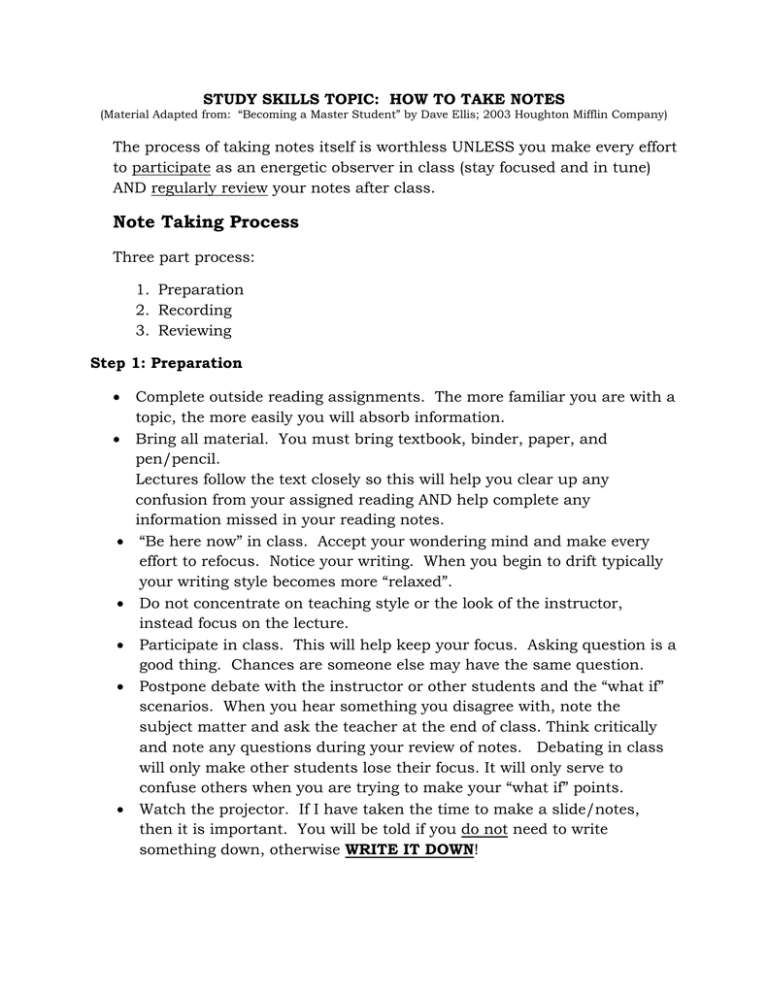
STUDY SKILLS TOPIC: HOW TO TAKE NOTES (Material Adapted from: “Becoming a Master Student” by Dave Ellis; 2003 Houghton Mifflin Company) The process of taking notes itself is worthless UNLESS you make every effort to participate as an energetic observer in class (stay focused and in tune) AND regularly review your notes after class. Note Taking Process Three part process: 1. Preparation 2. Recording 3. Reviewing Step 1: Preparation Complete outside reading assignments. The more familiar you are with a topic, the more easily you will absorb information. Bring all material. You must bring textbook, binder, paper, and pen/pencil. Lectures follow the text closely so this will help you clear up any confusion from your assigned reading AND help complete any information missed in your reading notes. “Be here now” in class. Accept your wondering mind and make every effort to refocus. Notice your writing. When you begin to drift typically your writing style becomes more “relaxed”. Do not concentrate on teaching style or the look of the instructor, instead focus on the lecture. Participate in class. This will help keep your focus. Asking question is a good thing. Chances are someone else may have the same question. Postpone debate with the instructor or other students and the “what if” scenarios. When you hear something you disagree with, note the subject matter and ask the teacher at the end of class. Think critically and note any questions during your review of notes. Debating in class will only make other students lose their focus. It will only serve to confuse others when you are trying to make your “what if” points. Watch the projector. If I have taken the time to make a slide/notes, then it is important. You will be told if you do not need to write something down, otherwise WRITE IT DOWN! Step 2: Record There are several formats of note-taking. Find a strategy that works for you (meaning you get the test grades you feel you are preparing for) and use that strategy. You can use one or more strategies. 1. Cornell format: Draw a vertical line, top to bottom, 1 ½ inches from left edge of paper. Write your notes to the right of the line. Reserve the area to the left of the line for key word clues and sample questions. Fill in the left-hand column when you review your notes. A chapter of material will have several pages of Cornell notes. 2. Mind Maps: You will need plenty of room. A chapter of material will have several connected mind maps. Turn your paper sideways (landscape) and you will take notes horizontal. Determine main concept of lecture/reading. Write that in center of page and circle it. Record concepts related to the main concept on lines radiating from the center. Mind mapping can get jumbled and congested, if you prefer mind mapping, you may want to look into free mind mapping websites on the Internet. Mind mapping: http://bitesizebio.com/articles/free-mind-mapping-software/ 3. Outline format: You can use standard Roman numeral outline or a free form, indented outline. This form illustrates major points and supporting ideas. You are recording and organizing material at the same time. http://learningcommons.ubc.ca/note-taking/ TIPS: You may want to use only one side of the paper. When you review, you may find it easier to spread all of your notes out side by side. Leave blank space. Tightly crammed notes are hard to read and review. Also, you can write questions or other notes when you review. Label, page number, and date all notes. (include Units #’s, chapter #’s, and page #’s) Step 3: Review 1. ESSENTIAL TO NOTE-TAKING. Review within 24 hours. The sooner you review your notes the better. Remember, it is possible to forget up to 80% of the material within 24 hours-unless you review! 2. Edit Notes. During the first review fix words that are illegible. Write out any abbreviated words so you can remember later. If you cannot read something or do not understand something, make a note. Ask the instructor or another student. 3. Conduct short weekly review periods. Once a week, review your notes again. Just a 20-minutes review session is valuable. 4. Consider typing your notes. Why? Typed notes are easier to read AND the process of typing them forces you to review them.
